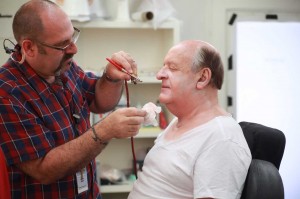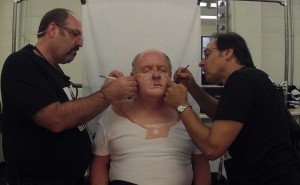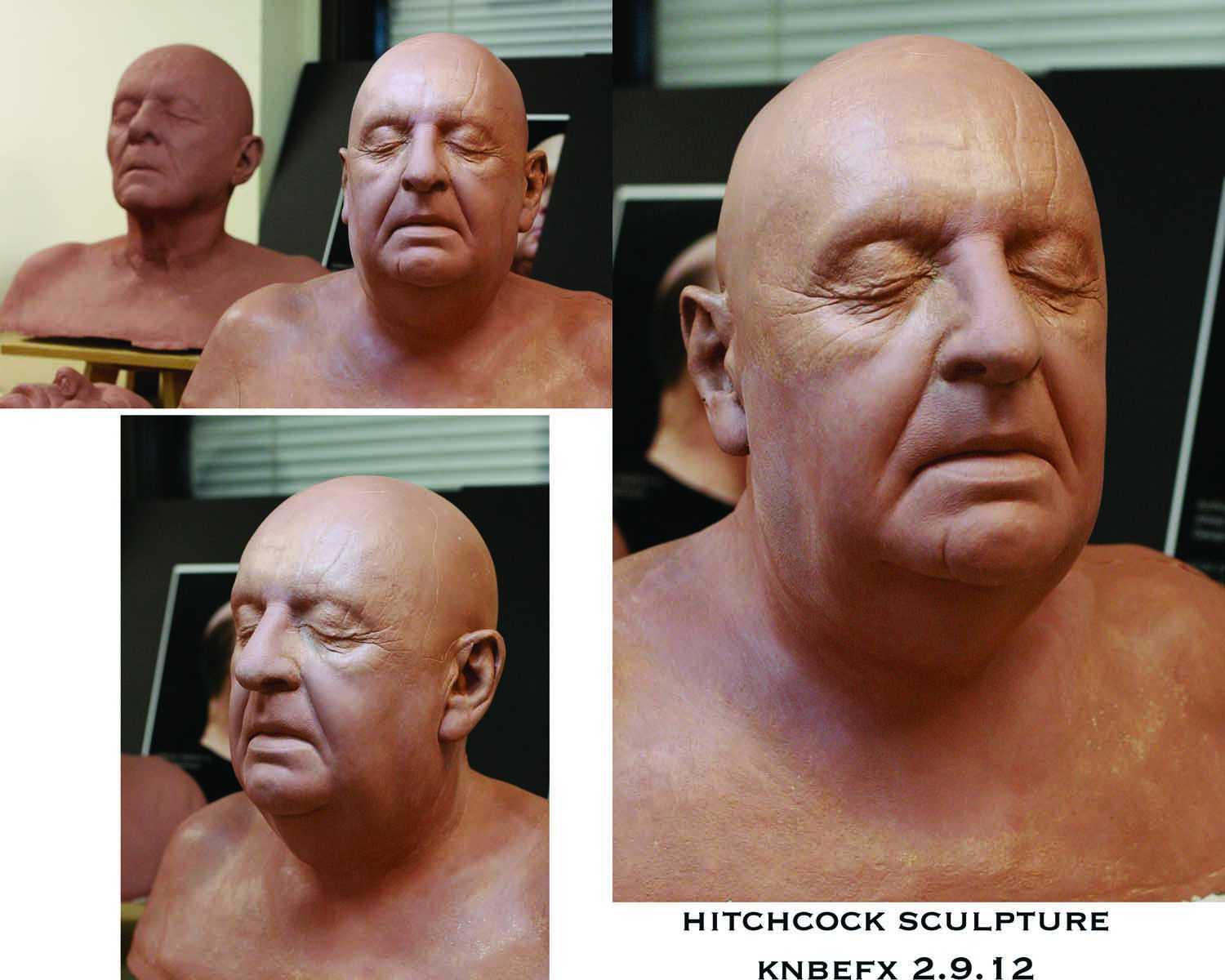
Set in 1959 and 1960, Sacha Gervasi’s new semi-biographical film Hitchcock focuses on the titular director’s attempt to make the controversial horror picture Psycho. As Anthony Hopkins had been attached to play lead character of Alfred Hitchcock for a long period prior to production, when makeup artist and designer Howard Berger was brought in to create the character makeup, he began six weeks of testing six separate makeup designs on Hopkins before settling on a final version the night before shooting. “Something one has to remember is this is not a likeness makeup or a character makeup,” Berger revealed. “It’s a portrait of Alfred Hitchcock on Anthony Hopkins. It was supposed to remind us of Alfred Hitchcock. It is not Alfred Hitchcock, but Tony portraying him.”
At first, after several makeup tests closely emulated Hitchcock but lost Hopkins’ unmistakable face in the process, Richie Alonzo was brought on to sculpt the makeups at Berger’s KNB EFX Group Studios in the San Fernando Valley. Then Berger and key makeup artist Peter Montagna did the actual makeup application as a team.
The cornerstone of the makeup was one large horseshoe-shaped makeup appliance which included a neck and chin, cut right underneath Hopkins’ own lower lip, went up along the sides of his face, swooped across his cheekbone and then went underneath his ears and blended into the nape of his neck. Also included were earlobes, a nose tip, brown contact lenses and a top of the head lace hairpiece, which Martin Samuels cut and colored and involved partially shaving back Hopkins’ own hair.
Created at KNB EFX GROUP, the appliances were manufactured in silicone, a material that has become preferable for creating realistic character makeups. “The way movies are made today, with digital cinematography, silicone is the best option,” Berger said of the current material of choice in his craft. “I wanted the weight, density and translucency of the skin that only silicone can give me. Silicone is a more stable material than gelatin, which can melt, and silicone looks more realistic than foam rubber these days.”

Due to the intrinsic nature of the silicone, Berger and Montagna more easily painted the appliances after each of them was glued them down onto Hopkins’ face. “We were able to color match the base of the silicone to Tony’s own skin color,” Berger said. “I ended up using very few colors – two were tattoo colors, a red and a brown freckling, and then used two different MAC Cosmeticmicronized makeup bases and airbrushed the colors over the reds and browns to give it a more natural, lush skin tone and quality.”
Because Hopkins is 75 years-old, Berger wanted to limit the actor’s time in the makeup chair as Hopkins worked for 33 of the 35 shooting days during principal photography. “He was in the chair an hour-and-a-half with hair and lenses, and he’d go get dressed in the fat undersuit and costume,” stated Berger. “Peter and I had a ballet-like approach to make it all happen. I would place the horseshoe piece and glue one side, and Peter would do the other side. We would each do an ear, Peter did the nose tip, I painted [the makeup], and then Peter tied it all together with lips and eyes. Tony was so cooperative on every level. He never moves.”

Due to the stability of the silicone, Hopkins needed only infrequent touch-ups, such as after lunch. “He wasn’t going to set unless he was Alfred Hitchcock,” Berger noted. “You never thought that it was Tony in a makeup. In the 33 days, I spent three hours with Anthony Hopkins; the rest of the time, I was with Alfred Hitchcock.”
Ultimately, Berger sounded pleased with his final results with Hopkins in Hitchcock, especially for a $13 million dollar film in an age of routine $100 million films and above. “My big payback is that my peers like it,” Berger reflected. “Rick Baker said it was the best makeup I ever did. That meant a lot because I am the biggest Rick Baker fan. I felt like I did my job well.”






